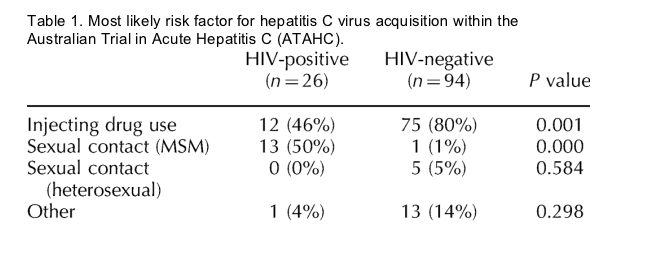| |
Further evidence of HCV sexual transmission among HIV-positive men who have sex with men: response to Danta et al.
[Correspondence]
|
| |
| |
AIDS:Volume 21(15)1 October 2007p 2112-2113
Matthews, Gail Va; Hellard, Margaretb; Kaldor, Johna; Lloyd, Andrewc; Dore, Gregory Ja
aNational Centre in HIV Epidemiology and Clinical Research, University of New South Wales, Sydney, Australia
bThe Macfarlane Institute for Medical Research and Public Health, Melbourne, Australia
cSchool of Medical Sciences, University of New South Wales, Sydney, Australia.
In a recent paper Danta and colleagues [1] described the clinico-epidemiological and molecular characteristics of a recent epidemic of acute hepatitis C occurring in HIV-positive men who have sex with men (MSM) in London. Through a well-designed case-control study Danta et al. [1] identified particular patterns of sexual behaviour associated with new infections, and with additional phylogenetic analysis provided convincing evidence for the role of per-mucosal hepatitis C virus (HCV) transmission within this population. Similar reports, albeit on a smaller scale, have been published from HIV-positive cohorts in France and Holland [2-4], suggesting that these outbreaks of hepatitis C in HIV-positive homosexual men are not confined to one European location. Here, we report similar cases in the Australian setting.
The Australian Trial in Acute Hepatitis C (ATAHC) is a prospective study of the natural history and treatment outcomes in acute HCV ongoing at 21 sites in Australia, funded by the United States National Institutes of Health. The ATAHC study is primarily focussed on HCV transmission through injecting drug use (IDU), and study sites include both primary care sites with high caseloads of injecting drug users as well as tertiary care hepatitis clinics. Since August 2004, 120 subjects have been enrolled with the prospective collection of behavioural, clinical, and virological data. Detailed risk behaviour questionnaires are completed by participants at baseline and 6 monthly, and include both self-determined and clinician assessment of the most likely mode of HCV acquisition. Acquisition through IDU is assumed if either the clinician or patient identified injecting as the most likely mode of acquisition. Interim analysis has identified significant differences in the most likely risk factor for HCV acquisition between the HIV-negative group (n = 94) and the HIV-positive group (n = 26) (Table 1).

All of the HIV-positive group gave a history of male to male sex, and sexual contact with a male partner was identified as the most likely mode of acquisition in 13 cases, or half of this group. Of these 13 cases, 38% reported their most likely mode of transmission as having a sexual partner who was known to have chronic hepatitis C infection, the others reported sexual transmission with same sex partners of unknown status. In contrast, sexual transmission was identified as the most likely mode of transmission in only 6% of the HIV-negative group, and only one case gave a history of male to male sex as the most likely mode of transmission. In addition, the HIV-positive subjects who did report injecting differed from the HIV-negative group with a later age of onset of first injecting (30 versus 23 years, P = 0.005), and the use of crystal methamphetamine (ice) as opposed to heroin as their drug of first choice, suggesting different patterns and frequencies of drug use within this group.
Our findings are of interest for a number of reasons. The apparent high rate of non-injecting sexual HCV transmission within HIV-positive MSM seen in this multicentre Australian study mirrors that described in Europe, and suggests that factors driving the epidemiology of acute HCV infection in this population are prevalent globally. As Danta and colleagues [1] noted, the potential mechanisms for increased rates of sexual transmission of HCV in the HIV-positive population may involve higher serum and semen viral loads, immunological impairment in the mucosal compartment, or unique high-risk sexual behaviours.
Our study, unlike the European cohorts, has concurrently enrolled both HIV-negative and HIV-positive individuals, thus allowing a unique comparison of the differences between these two groups in terms of behavioural, immunological and virological characteristics of acute hepatitis C. The apparently low rate of sexual HCV transmission in the HIV-negative group within our study is consistent with the prevailing view of IDU as the predominant mechanism of transmission in this population. Comprehensive analysis of virological and behavioural risk factors in both HIV-positive and HIV-negative individuals will help further define the mechanisms underlying per-mucosal HCV transmission in HIV-positive MSM.
|
|
| |
| |
|
|
|